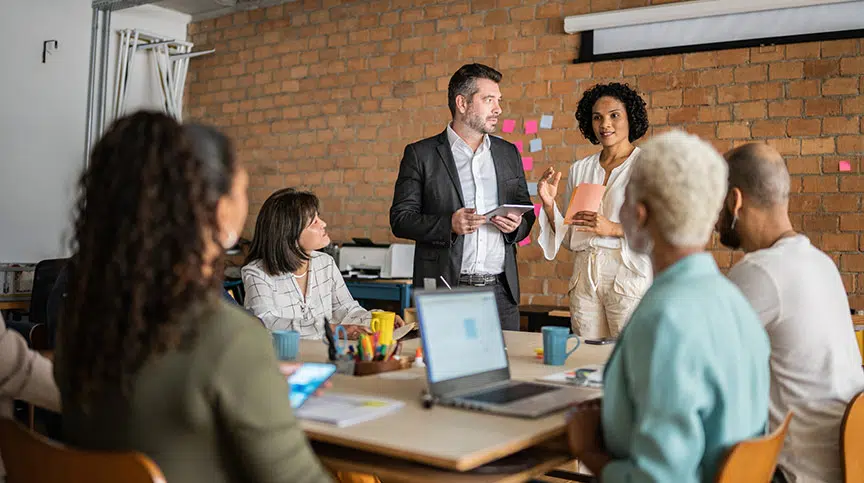What Makes Innovative Companies Different? They Understand the Innovation Equation
Innovate or die — everyone says it, but few organizations really know how to make innovation happen.
We’ve heard the cautionary tales. Blockbuster missed the opportunity to innovate around streaming video rentals and lost their once-cornered market to Netflix. Kodak, the former leader in the film industry, filed for bankruptcy in 2012 because it struggled to adapt to the world of digital photography — a technology that it invented.
And more recently, in the midst of the COVID pandemic, swaths of industries were crippled as they found existing business models disrupted — some temporarily, and others permanently obsolete. Hanging on required companies to reinvent their offerings. Those who were already struggling, especially if because of a failure to adapt to changing customer preferences, found it was too late to begin focusing on organizational innovation.
Experts note the following organizational innovation trends:
- Organizational innovation is regularly cited as one of the top 10 trends affecting business and leadership.
- Executives cite creativity as the #1 leadership skill needed for dealing with an increasingly complex future.
- Creativity and innovation are generally seen as essential requirements for organizational success.
- Willingness to rapidly prototype early versions of innovations is one of the top 10 leadership skills needed for future success.
Despite the consensus around the importance of organizational innovation, it continues to be an area in which leaders and organizations struggle. Given that leaders and organizations seem to care a great deal about being innovative, what’s holding them back? Why aren’t companies as innovative as they want to be? We believe it’s because of a lack of understanding both sides of the innovation equation, a both / and proposition.
The Innovation Equation for Organizational Innovation
Some leaders believe that all they have to do is hire creative people and innovation will just happen. And organizations do need leaders with the ability — and willingness — to think beyond short-term needs and to resist the temptation to cut back on the resources that feed innovation.
Other leaders believe that innovation is all about organizational processes — that all employees will prove to be equally innovative, under the right circumstances and with the right organizational structures (and compensation) encouraging them.
But the most creative person in the world is unlikely to innovate effectively in a company that does not support organizational innovation, and even the most innovation-supportive companies in the world will not reach their innovation potential without creative people in place to do the work.
The bottom line is that organizational innovation follows a simple innovation equation. And the innovation equation isn’t about either having creative people or creating a workplace that fosters innovation — because, for organizational innovation, both must be present.
That’s why the organizational innovation equation is: People + Context = Innovation. For even more on this, including specifics for leaders on what does and doesn’t motivate people to support more organizational innovation, explore our white paper on the innovation equation.
How Companies Can Foster Organizational Innovation
To better understand how organizational innovation works, and how companies can operationalize innovation to support both sides of the innovation equation, we asked 485 leaders from organizations around the globe to share their experiences with innovation in the workplace.
Their responses offered insights into how organizations encourage innovation — as well as common roadblocks they face when trying to implement organizational innovation.
Our research paper on organizational innovation roadblocks summarizes findings from our survey, which revealed the following 5 key differences separating organizations that are effective at innovation from those that are not.
5 Ways to Build Innovation in Your Organization
1. Leaders encourage innovation.
Nearly a third of people surveyed from ineffective organizations selected “leaders don’t encourage innovation” as one of their 3 main roadblocks, compared to only 9% from effective organizations. By definition, innovation is strange and different, and without the risk tolerance and psychological safety at work to experiment, prototype, and pilot new concepts, leaders’ actions speak louder than any hollow words of encouragement.
- Questions to consider: Do leaders in your organization allow people to take a chance on innovation? How could your organization work to ensure alignment between what it said about innovation being important, and actual leadership behaviors?
- Organizational innovation leadership tip: Rather than using innovation as merely a buzzword, demonstrate behaviors that actively encourage innovation. (Be sure leaders know how to encourage innovation, not unintentionally sabotage it, and understand how to foster innovative mindsets.)
2. The culture fosters innovation.
More than half (56%) of respondents from ineffective organizations selected “culture that does not support innovation” as an innovation roadblock. In contrast, only 11% of respondents from effective organizations thought that organizational culture was a roadblock to innovation in their organizations.
- Questions to consider: What could your organizational culture leverage to encourage innovation? What cultural obstacles need to be broken down?
- Organizational innovation leadership tip: Think of organizational culture as “the ways that things really get done around here” (versus official processes). Culture change takes years, yet by looking at what’s working in the culture that can be leveraged — as well as what overtly blocks innovation — organizations can begin to create a culture of innovation.
3. There’s a formal innovation strategy.
When asked whether their organizations had a formal approach to innovation, 66% of respondents from effective organizations said yes, compared with 20% of respondents from ineffective organizations. Many of these ineffective organizations are relying only on informal efforts.
After all, it is the task of leaders to understand both how to run the day-to-day business and invest in the innovation process to support the future of the organization. Managing this tension or polarity is not a bad thing; it’s about finding balance. Managing limited resources and establishing the right level of risk-taking are 2 important aspects of finding this balance.
- Questions to consider: How might you develop a formal innovation strategy? How might your organization align people, processes, and output with your organizational culture and environment?
- Organizational innovation leadership tip: Develop a formal strategy for innovation — unique to your organization — taking into account the 3 practices that will help drive innovation in your organization. Then, outline the best ways to communicate that strategy to your employees.
4. There’s money in the budget.
Innovative organizations have funds dedicated to innovation. Of the people surveyed, 90% of respondents from effective organizations said their organization has an innovation budget, while only 58% of respondents from ineffective organizations said the same.
Simply put, organizational innovation requires resources. Many organizations that are effective at innovation put in place innovation venture capital funds to build and run experiments that determine the viability of concepts.
- Questions to consider: How does your organization currently budget for innovation? How might you free up venture capital funds for experiments and prototypes?
- Organizational innovation leadership tip: Remember that creating and implementing something new and valuable is not cheap, and should be viewed as a critical, long-term investment.
5. Leaders set the direction for innovation.
Innovative organizations have a clear direction for innovation. While only 17% of respondents from effective organizations selected this issue, 39% of respondents from ineffective organizations selected “no clear direction” as a major roadblock.
So whether you’re an executive who leads the entire organization through innovation, a functional leader who is responsible for directing and promoting that innovation, or a manager who is simply advocating for and/or implementing innovative ideas, remember that organizational innovation is a means to an end, not the end in and of itself. It requires constant facilitation and support, and your role in innovation depends on where you sit in the organization But while the responsibilities for innovation vary by leader level, don’t lose sight of why organizational innovation is important. Start with a clear statement of purpose for innovation, with very few objective measures of success, to build aligned efforts within the organization and ensure that the work being done is focused on the desired outcome.
- Questions to consider: How might your organization create clear direction, alignment, and commitment for innovation?
- Organizational innovation leadership tip: Start with a clear statement of purpose for innovation, with objective measures of success. This helps to align efforts within the organization and ensure that work toward that goal is focused on the desired outcome.
Ready to Take the Next Step?
Build a culture of organizational innovation and help your people understand the innovation equation with a customized learning journey for your leaders using our research-backed modules. Available leadership topics include Change & Disruption, Innovation Leadership, Learning Agility, Psychological Safety, and more.















